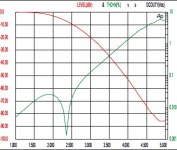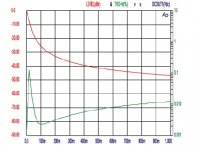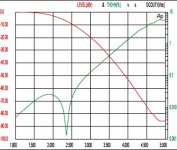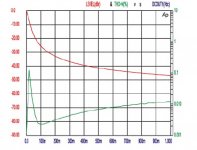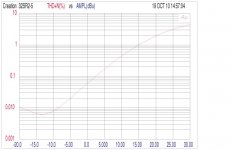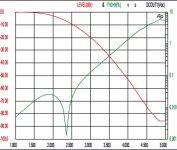I think wetted mercury reed relays in a dB-linear binary weighted attenuater will most certainly outrule the other options. Very costly and critical in a few aspects, though.Tolu said:3. Relay attenuator (passive)
Regards, Klaus
Hi KSTR
I have some MEDER reed relais in my tinker box. I don't know if they are mercury wetted. Are any reed relais mercury wetted?
Some DIYer have the opinion that gold plated relays sound better than reed relays. Another guy of this thread tried out the Lightspeed and returned to the relay attenuator solution because he complained about distortion with the Lightspeed.
Do you have a supplier and type for this relays and have you experienced how they sound?
Regards
Thomas
I have some MEDER reed relais in my tinker box. I don't know if they are mercury wetted. Are any reed relais mercury wetted?
Some DIYer have the opinion that gold plated relays sound better than reed relays. Another guy of this thread tried out the Lightspeed and returned to the relay attenuator solution because he complained about distortion with the Lightspeed.
Do you have a supplier and type for this relays and have you experienced how they sound?
Regards
Thomas
Mercury Relays
Hi,
I started out by designing a conventional mercury wetted relay attenuator for my Aleph P1.7 boards. I have the design and a large number of the mecury relays ready for it. I then saw Georges thread and decided I would try that too and see which was best.
If anyone requires mercury relays to try, please let me know. I bought them at a good price 🙂
Hi,
I started out by designing a conventional mercury wetted relay attenuator for my Aleph P1.7 boards. I have the design and a large number of the mecury relays ready for it. I then saw Georges thread and decided I would try that too and see which was best.
If anyone requires mercury relays to try, please let me know. I bought them at a good price 🙂
Hi Thomas,
IMHO the best pice/value ratio you will get with the Coto 2200-2301 which lists for 8.50EUR at farnell:
http://de.farnell.com/jsp/Elektrote...LOGY/2200-2301/displayProduct.jsp?sku=1081643
It is a gold plated reed relay, hermetically sealed and with magnetic and electrostatic shields. They are used in the most demanding measurent applications and are rated to last for min. 5 million cycles under full load. Typical life span will exceed 500 million cycles (that equivalents to 15 years when switched every second!). I don't know the sound quality and sort of refuse to assign one to them (as it definitely depends more on the circuit you build around them than on the relays themselves). But I used them for critical low level measurement equipment which is comparable if not more demanding than audio.
The pin-compatible Coto 2920 is a wet Hg model with 1000 million rated cycles and 75mOhms contact resistance. These are hard to get (currently not listed at farnell and non-stocked at digikey and mouser and list for USD20 in 100+ quantities). These are the best relays I know of and are only used when an already excellent gold plated one is not good enough. If you google for "wetted mercury relay" you may find other suppliers of these type of relay.
Or be quick to get your share from Barry's personal special limited reserve. 😀
Regards, Klaus
IMHO the best pice/value ratio you will get with the Coto 2200-2301 which lists for 8.50EUR at farnell:
http://de.farnell.com/jsp/Elektrote...LOGY/2200-2301/displayProduct.jsp?sku=1081643
It is a gold plated reed relay, hermetically sealed and with magnetic and electrostatic shields. They are used in the most demanding measurent applications and are rated to last for min. 5 million cycles under full load. Typical life span will exceed 500 million cycles (that equivalents to 15 years when switched every second!). I don't know the sound quality and sort of refuse to assign one to them (as it definitely depends more on the circuit you build around them than on the relays themselves). But I used them for critical low level measurement equipment which is comparable if not more demanding than audio.
The pin-compatible Coto 2920 is a wet Hg model with 1000 million rated cycles and 75mOhms contact resistance. These are hard to get (currently not listed at farnell and non-stocked at digikey and mouser and list for USD20 in 100+ quantities). These are the best relays I know of and are only used when an already excellent gold plated one is not good enough. If you google for "wetted mercury relay" you may find other suppliers of these type of relay.
Or be quick to get your share from Barry's personal special limited reserve. 😀
Regards, Klaus
Re: Mercury Relays
Hi Barry
what was your result. Which one was best? Lightspeed or Mercury?
Have you already finalised your Lightspeed with µC and DAC? What kind of DAC do you use?
Regards
Thomas
barryblue said:Hi,
I started out by designing a conventional mercury wetted relay attenuator for my Aleph P1.7 boards. I have the design and a large number of the mecury relays ready for it. I then saw Georges thread and decided I would try that too and see which was best.
If anyone requires mercury relays to try, please let me know. I bought them at a good price 🙂
Hi Barry
what was your result. Which one was best? Lightspeed or Mercury?
Have you already finalised your Lightspeed with µC and DAC? What kind of DAC do you use?
Regards
Thomas
Silonex datasheets
Silonex datasheets are available here:
http://www1.silonex.com/audiohm/index.html
Silonex datasheets are available here:
http://www1.silonex.com/audiohm/index.html
georgehifi said:At CD highest playback level <2v the Silonex LDR's are still below .01% and that is 2nd harmonic in nature, which if anything is pleasing to the ear, ask any tube guru.
That's a pretty spectacular number. Can you point me to the
source?
😎
Nelson Pass said:
That's a pretty spectacular number. Can you point me to the
source?
😎
What Silonex sent me when I asked them the question. "At CD levels <2v, are the distortion figures less than .1%."
They replied. "Better, and whats there is 2nd harmonic."
And sent me this.
Cheers George
Attachments
georgehifi said:They also sent this one which is 1v max input. Which is closer to what cd gives out when playing actual music material.
George, there are two curves - the one you have a thumbnail
of (which I can't read the axis legends on) and the one I bring
up (by save target as...) which has more pixels but is not the
same curve.
Can you show us the higher res version of the thumbnail?
😎
Nelson Pass said:
George, there are two curves - the one you have a thumbnail
of (which I can't read the axis legends on) and the one I bring
up (by save target as...) which has more pixels but is not the
same curve.
Can you show us the higher res version of the thumbnail?
😎
1/2
Attachments
Thanks ZEN, be damed if I could figure out how to do that!!!!!!!!!
Better Nelson, sounds like your just as blind as me, TOO many semiconductor and circuit diagrams been looked at in bad light. Lucky we can still hear!
Cheers George
Better Nelson, sounds like your just as blind as me, TOO many semiconductor and circuit diagrams been looked at in bad light. Lucky we can still hear!
Cheers George
georgehifi said:................. Lucky we can still hear!
.............
you and Papa...... hear?
naah...........

edit:
now- for change- serious Q from me........
I need (probably 10^6 times asked ) short'n'sweet info:
which LDRs and where in Europe to buy them?
anyone ?
georgehifi said:Beter Nelson, sounds like your just as blind as me, TOO many semiconductor and circuit diagrams been looked at in bad light.
Most likely. I wear three different diopters and sit in front of
a 37 inch monitor.
The attenuation level and distortion figures are clear, but I
don't see a reference for the dBr voltage. What do you suppose
is meant by the X axis labeled as "DCOUT1(Vdc)"?
If we can find out the reference voltage, we can tell a lot more
from these curves.
I speculate that the first curve is two attenuators with the output
as center tap, judging by the range of attenuation. If that is
so then we can imagine that the dip in the curve at 2.3V is 2nd
harmonic cancellation of the two elements - this makes sense
as the level is -6 dB, with both elements at equal value. At this
point, what is left will be 3rd harmonic.
In the second curve it looks to be a single element. Oddly, it has
a large jump in the distortion value at about the -6dB point, and
this is where the information about the DCOUT1(Vdc) would
come in handy.
😎
Zen Mod said:
I need (probably 10^6 times asked ) short'n'sweet info:
which LDRs and where in Europe to buy them?
anyone ?
I think for you Zen here is the best place.
http://www.rsonline.de/cgi-bin/bv/r...keifcefeceeldgondhgh.0&cacheID=deie&Nr=avl:de
Cheers George
Nelson Pass said:What do you suppose is meant by the X axis labeled "DCOUT1Vdc)"?😎 /B]/QUOTE]
I thought dcoutVdc meant same as dcinVdc seeing it's a passive device and has no gain, and using DC Volts instead of AC Volts to do their measurements
Cheers George
georgehifi said:
I think for you Zen here is the best place.
http://www.rsonline.de/cgi-bin/bv/r...keifcefeceeldgondhgh.0&cacheID=deie&Nr=avl:de
Cheers George


- Home
- Source & Line
- Analog Line Level
- Lightspeed Attenuator a new passive preamp
